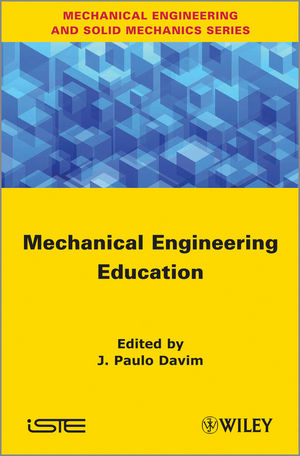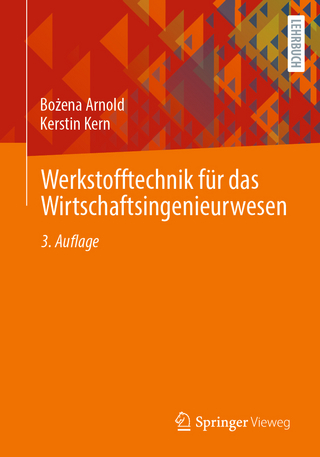
Mechanical Engineering Education
ISTE Ltd and John Wiley & Sons Inc (Verlag)
978-1-84821-381-4 (ISBN)
- Titel z.Zt. nicht lieferbar
- Versandkostenfrei
- Auch auf Rechnung
- Artikel merken
Mechanical Engineering is defined nowadays as a discipline “which involves the application of principles of physics, design, manufacturing and maintenance of mechanical systems”. Recently, mechanical engineering has also focused on some cutting-edge subjects such as nanomechanics and nanotechnology, mechatronics and robotics, computational mechanics, biomechanics, alternative energies, as well as aspects related to sustainable mechanical engineering.
This book covers mechanical engineering higher education with a particular emphasis on quality assurance and the improvement of academic institutions, mechatronics education and the transfer of knowledge between university and industry.
J. Paulo Davim is Aggregate Professor at the Department of Mechanical Engineering of the University of Aveiro, in Portugal. He is also the Head of the Machining and Tribology Research Group. He is Editor in Chief of six international journals, as well as being a guest editor of journals, a book editor, a book series editor and the scientific advisory for many international journals and conferences. In addition, he has authored and co-authored more than 40 book chapters and 350 articles in journals and conferences.
Preface xi
Chapter 1. Quality Assurance in Greek HEIs: Convergence or Divergence with European Models? 1
Nikolaos M. VAXEVANIDIS
1.1. Introduction 1
1.2. Definitions and fundamentals 3
1.3. Quality management models in HE 6
1.3.1. Overview 6
1.3.2. Implementation of ISO 9001 in HEIs 11
1.3.3. Implementation of EFQM model in HEIs 14
1.4. European focus on quality in HE: a historical perspective 16
1.4.1. Historical perspective 16
1.4.1.1. Policy and procedures for quality assurance 22
1.4.1.2. Approval, monitoring and periodic review of programs and awards 23
1.4.1.3. Assessment of students 24
1.4.1.4. Quality assurance of teaching staff 26
1.4.1.5. Learning resources and student support 26
1.4.1.6. Information systems 27
1.4.1.7. Public information 28
1.4.2. ESG standards versus typical quality systems 28
1.4.3. Accreditation of engineering education 31
1.5. Quality assurance in Greece: a long and winding road 33
1.5.1. Higher education in Greece 33
1.5.2. Greek HEI quality assurance system 36
1.5.3. Accreditation of higher engineering education in Greece 44
1.5.4. Selected cases on QA applications in Greek (engineering) HEIs 45
1.6. Bibliography 52
Chapter 2. Mechatronics Education 61
Uday Shanker DIXIT
2.1. Introduction 61
2.2. A brief history of mechatronics 63
2.2.1. History of mechanical engineering 63
2.2.2. History of electronics engineering 68
2.2.3. Growth of mechatronics 71
2.3. Definitions and scope of mechatronics 72
2.4. Examples of mechatronic products 76
2.5. Review of literature in the area of mechatronics education 78
2.6. Common doubts regarding the discipline of mechatronics 84
2.7. Characteristics of mechatronics education 86
2.8. Incorporating mechatronics in the course structure of undergraduate students 89
2.9. Mechatronics for postgraduate students 94
2.10. Planning of a mechatronics program at postgraduate and undergraduate level 95
2.11. Some examples of mechatronics projects 98
2.11.1. Design and fabrication of a mechatronic wheelchair 98
2.11.2. Automatic gear changing system for cars 99
2.11.3. Design and fabrication of robots 100
2.11.4. Design and fabrication of an electronic cam 101
2.12. Conclusion 102
2.13. Bibliography 103
Chapter 3. Mechatronics Educational System Using Multiple Mobile Robots with Behavior-Based Control Approach 107
Fusaomi NAGATA, Keigo WATANABE and Maki K. HABIB
3.1. Introduction 108
3.2. Mechatronics education subsystem I 108
3.2.1. Hardware of mechatronics educational subsystem I 108
3.2.2. Basic dialog for students’ experiment 112
3.3. Mechatronics educational subsystem II 113
3.3.1. Hardware of mechatronics educational subsystem II 113
3.3.2. Basic dialog for students’ experiment 115
3.4. Mechatronics educational subsystem III 116
3.4.1. Mobile robot with three wheels 116
3.4.2. Network-based multiple mobile robot system 120
3.4.3. Subsumption control architecture implemented on supervisory server 121
3.4.3.1. Move forward 123
3.4.3.2. Turn to left or right 124
3.4.3.3. Avoid objects 124
3.4.4. Agent dispatcher 126
3.4.5. Multiple sensory sensors 126
3.5. Conclusions 127
3.6. Bibliography 128
Chapter 4. Knowledge Transfer between University and Industry: Development of a Vision Measuring System 131
João M.G. FIGUEIREDO
4.1. Introduction 132
4.2. Measuring system 136
4.2.1. Light plane 138
4.2.2. Mathematical model 140
4.2.3. System calibration 147
4.3. Image processing algorithm 149
4.4. Results 150
4.4.1. Building the wheel’s profile in the horizontal light plane 150
4.4.2. Building the wheel’s profile in the radial plane 153
4.4.3. Experimental results 155
4.5. Conclusions 159
4.6. Acknowledgment 160
4.7. Bibliography 160
List of Authors 165
Index 167
| Verlagsort | London |
|---|---|
| Sprache | englisch |
| Maße | 161 x 241 mm |
| Gewicht | 463 g |
| Themenwelt | Technik ► Maschinenbau |
| ISBN-10 | 1-84821-381-6 / 1848213816 |
| ISBN-13 | 978-1-84821-381-4 / 9781848213814 |
| Zustand | Neuware |
| Informationen gemäß Produktsicherheitsverordnung (GPSR) | |
| Haben Sie eine Frage zum Produkt? |
aus dem Bereich


